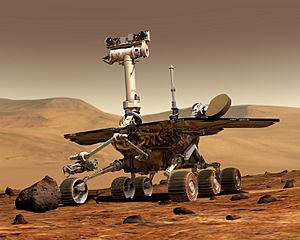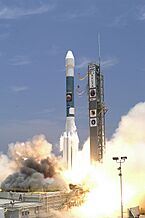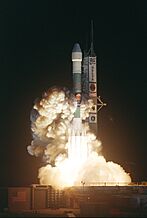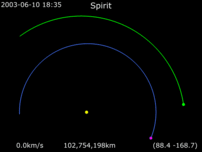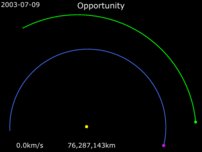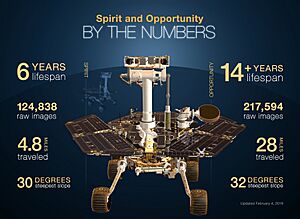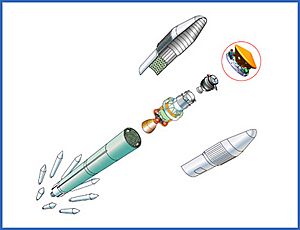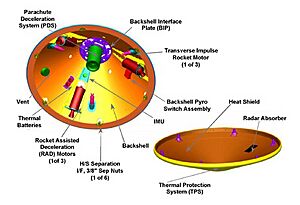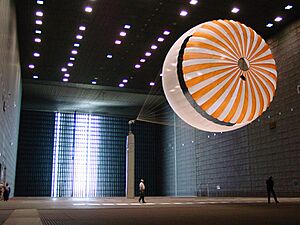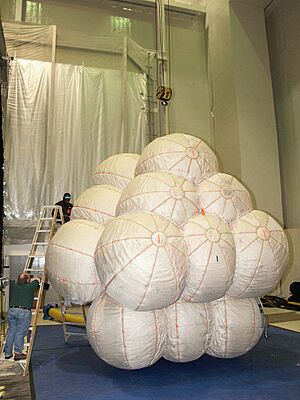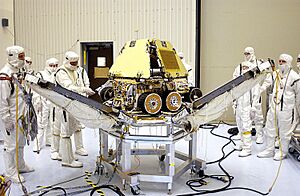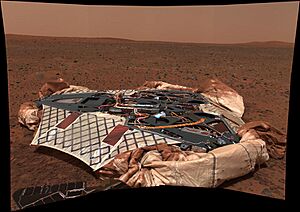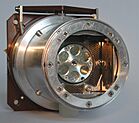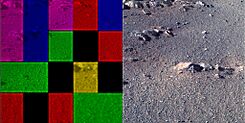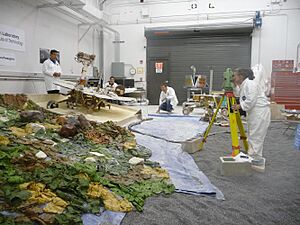Mars Exploration Rover facts for kids
The Mars Exploration Rover (MER) mission was a space project by NASA. It sent two Mars rovers, named Spirit and Opportunity, to explore the planet Mars. The mission started in 2003 when the two rovers were launched. They both landed on Mars in January 2004, in different places.
The rovers were only planned to work for 90 Martian days. But they lasted much, much longer! Spirit worked until March 22, 2010. Opportunity kept going until June 10, 2018. This mission was a huge success for exploring Mars.
Contents
Mission Goals
The main goal of the mission was to look for and study rocks and soil that could tell us about water on Mars in the past. Scientists wanted to find out if Mars once had liquid water. This mission was part of NASA's bigger Mars Exploration Program. This program had already sent other successful landers to Mars, like the Viking program landers in 1976 and the Mars Pathfinder probe in 1997.
The Mars Exploration Rover mission had several important science goals:
- Find and study different kinds of rocks and soils that show signs of past water activity. This included looking for minerals that form when water is present, like from rain, evaporation, or hot springs.
- Map out where minerals, rocks, and soils are located around the landing sites. Also, figure out what they are made of.
- Understand what geologic processes shaped the land and its chemistry. This could include things like water or wind erosion, volcanoes, or impacts from space rocks.
- Check and confirm observations made by instruments on the Mars Reconnaissance Orbiter (MRO) from space. This helped make sure the orbital instruments were accurate.
- Look for minerals that contain iron. Also, find and measure how much of certain minerals that contain water, or were formed by water, are present.
- Study the minerals and textures of rocks and soils to learn how they were created.
- Find clues in the geology about what the environment was like when liquid water was on Mars.
- Figure out if those past environments could have supported life.
Building, launching, landing, and running the rovers for their first 90-day mission cost about $820 million. Both rovers kept working so well that their missions were extended five times! The first four extensions cost $104 million, and the fifth cost at least $20 million. The Jet Propulsion Laboratory (JPL) managed the mission. They designed, built, and operated the rovers.
Because the rovers gathered so much scientific information, two asteroids were named after them: 37452 Spirit and 39382 Opportunity.
Mission Journey
Launch and Landing
Spirit (MER-A) launched on June 10, 2003. Opportunity (MER-B) launched on July 7, 2003. Both probes launched on Boeing Delta II rockets from Cape Canaveral Space Launch Complex 17 in Florida. The launch sites were right next to each other. This allowed NASA to launch both rovers within a short time.
The rovers landed on Mars in January 2004, in places far apart from each other. On January 21, 2004, NASA briefly lost contact with Spirit. It turned out to be a problem with the rover's flash memory. Engineers fixed it by updating the software. Spirit was back to full science work by February 5. Both missions were only supposed to last 90 Martian days.
On March 23, 2004, scientists announced a big discovery. They found strong evidence of past liquid water on Mars! Pictures and data from Opportunity showed layered rocks inside a crater. This suggested that water once flowed in that area. Also, the way chlorine and bromine were spread out suggested the area was once the shoreline of a salty sea that had dried up.
Sun · Earth · Mars · Rover
Mission Extensions
Because the rovers were still working well, NASA extended their missions many times.
- On April 8, 2004, NASA extended the mission from three to eight months.
- On September 22, NASA extended it for another six months. Opportunity was to explore Endurance crater and then head to Victoria crater. Spirit was to try and climb the Columbia Hills.
- Later, NASA extended the mission for another 18 months, until September 2006. On August 21, 2005, Spirit reached the top of Husband Hill after traveling 4.81 kilometers (about 3 miles).
On March 13, 2006, Spirit's front right wheel stopped working. The rover had to drag the broken wheel. It found a safe spot called "Low Ridge Haven" to spend the Martian winter. In September, Opportunity reached the edge of Victoria crater. On February 6, 2007, Opportunity became the first spacecraft to drive over 10 kilometers (6.2 miles) on Mars.
In July 2007, huge Martian dust storms blocked sunlight from reaching the rovers' solar panels. This made engineers worry that the rovers might stop working forever. But the dust storms eventually cleared, and the rovers started working again.
On October 1, 2007, both rovers began their fifth mission extension. This allowed them to explore Mars for five years, as long as they kept surviving.
On August 26, 2008, Opportunity began climbing out of Victoria crater. Scientists decided they had learned everything they could from inside the crater. Opportunity then returned to the flat plains to study different rocks. By January 2009, the two rovers had sent back 250,000 images and traveled over 21 kilometers (13 miles) combined.
On March 7, 2009, Opportunity saw the rim of Endeavour crater for the first time. It had driven about 3.2 kilometers (2 miles) since leaving Victoria crater. Meanwhile, Spirit got stuck deep in the Martian sand.
On January 26, 2010, after six years on Mars, NASA announced that Spirit would become a stationary research platform. They had tried for months to free it from the sand, but couldn't. The last time NASA successfully talked to Spirit was on March 22, 2010. On May 22, 2011, NASA stopped trying to contact Spirit.
On May 16, 2013, NASA announced that Opportunity had driven further than any other NASA vehicle on another world. It passed the distance driven by the Apollo 17 Lunar Roving Vehicle. On July 28, 2014, Opportunity drove over 40 kilometers (25 miles), beating the record held by the Russian Lunokhod 2 lunar rover. On March 23, 2015, Opportunity completed the full distance of a marathon (42.2 kilometers or 26.2 miles)! It took about 11 years and 2 months.
In June 2018, Opportunity was caught in a huge dust storm. Its solar panels couldn't get enough power. The last contact was on June 10, 2018. NASA tried to send commands after the storm, but the rover stayed silent. On February 13, 2019, NASA announced that the Opportunity mission was over. This also ended the 16-year Mars Exploration Rover mission.
Spacecraft Design
The Mars Exploration Rover spacecraft was designed to fit on top of a Delta II rocket. Each spacecraft had several parts:
- Rover: The robot that drives on Mars.
- Lander: The part that holds the rover and lands on Mars.
- Backshell / Parachute: The top part of the protective shell, with the parachute inside.
- Heat Shield: The bottom part of the protective shell.
- Cruise Stage: The part that travels through space from Earth to Mars.
- Propellant: Fuel for steering in space.
- Instruments: The science tools on the rover.
The total weight of each spacecraft was about 1,063 kilograms (2,344 pounds).
Cruise Stage
The cruise stage was the part of the spacecraft used for the journey from Earth to Mars. It was about 2.65 meters (8.7 feet) wide. It had solar panels that could make up to 600 watts of power near Earth and 300 watts at Mars.
Heaters and special insulation kept the electronics warm. A cooling system kept the computer from getting too hot.
The spacecraft used a star scanner and Sun sensor to know its position in space. Since the journey was 500 million kilometers (320 million miles), the spacecraft might go off course a bit. So, navigators planned several times to correct its path.
To keep the spacecraft on course, it carried about 31 kilograms (68 pounds) of fuel called hydrazine. Small thrusters used this fuel to make tiny adjustments to the spacecraft's speed and direction.
Communication
The spacecraft used a high-frequency X band radio to talk to Earth. This allowed it to use less power and smaller antennas.
Commands were sent through two antennas on the cruise stage: a low-gain antenna and a medium-gain antenna. The low-gain antenna was used when the spacecraft was close to Earth. As it got closer to Mars, the spacecraft switched to the medium-gain antenna, which sent a stronger signal towards Earth.
Aeroshell
The aeroshell was a protective cover for the lander during its seven-month trip to Mars. It protected the lander and rover from the extreme heat when entering the thin Martian atmosphere.
The aeroshell had two main parts: a heat shield and a backshell. The heat shield was flat and brownish. It protected the rover during entry and helped slow the spacecraft down. The backshell was cone-shaped and white. It held the parachute and other parts used during landing. These included rockets to slow down further and a unit to measure the spacecraft's position.
The aeroshell was made of a strong, lightweight material called an aluminum honeycomb structure. The outside was covered with a special material that burned away to get rid of the heat caused by friction with the atmosphere. This material was a mix of cork wood, a binder, and tiny silica glass spheres. It was designed to react with the Martian atmosphere and carry heat away. This helped the vehicle slow down from 19,000 to 1,600 kilometers per hour (12,000 to 1,000 miles per hour) in about a minute!
Parachute
The parachute helped slow the spacecraft down during entry, descent, and landing. It was stored in the backshell.
The parachute was 40% larger than the one used for the Mars Pathfinder mission. This was because the Mars Exploration Rover was heavier. It was made of strong, lightweight fabrics like polyester and nylon. Strong Kevlar ropes connected the parachute to the backshell.
The parachute was packed very tightly into a small space. Before launch, it was folded and pressed many times. It was also heated to make sure it was clean and free of germs.
Connected Systems
After the parachute opened about 10 kilometers (6 miles) above the surface, the heat shield was released. The lander then separated from the backshell and slowly lowered itself on a long, strong rope made of Zylon. Zylon is a very tough fiber, similar to Kevlar. This rope was about 20 meters (66 feet) long. It provided space for the airbags to inflate and kept the lander stable.
Because Mars' atmosphere is very thin (less than 1% of Earth's), the parachute alone couldn't slow the rover enough. So, rockets also fired to bring the spacecraft to a complete stop about 10 to 15 meters (33 to 49 feet) above the surface.
A radar altimeter measured the distance to the ground. When the lander was at the correct height, the Zylon rope was cut. This released the lander, allowing it to drop freely for a soft landing. The radar data also helped time the inflation of the airbags and the firing of the rockets.
Airbags
The airbags used for the Mars Exploration Rover mission were like those used by Mars Pathfinder in 1997. They had to be strong enough to cushion the spacecraft if it landed on rocks. They also needed to allow it to bounce across Mars' surface at high speeds (about 100 kilometers per hour or 62 miles per hour) after landing. The airbags had to inflate just seconds before touchdown and deflate once the rover was safely on the ground.
The airbags were made of Vectran, a material almost twice as strong as Kevlar. Each rover used four airbags, each with six connected sections. This connection helped absorb the landing forces. The airbags were not directly attached to the rover. Instead, ropes crisscrossed over them, holding them in place and giving them shape. Before landing, the airbags were stored with gas generators that inflated them.
Lander
The spacecraft lander was a protective shell that held the rover. Along with the airbags, it protected the rover from the impact forces during landing.
The lander was shaped like a tetrahedron (a pyramid with four triangular faces). Its sides opened like petals. It was strong and light, made of graphite fiber beams that were lighter than aluminum and stronger than steel. The rover was held inside the lander by bolts that were released with small explosives after landing.
Uprighting
After the lander bounced and rolled to a stop, it would rest on its base or one of its sides. Motors on the hinges of the petals then opened the sides to make the base flat and the rover upright. The rover had accelerometers to figure out which way was "down" (towards Mars' surface). The computer then told the correct petal to open to stand the rover upright. Once the base petal was down, the other two petals opened.
The petals opened to a flat position. If two petals landed on rocks, the base with the rover would be held up like a bridge. This kept the surface flat. The team on Earth could then send commands to adjust the petals. This created a safe path for the rover to drive off the lander and onto the Martian surface.
Moving the Rover onto Mars
Getting the rover off the lander is called the "egress phase." The rover had to avoid getting its wheels caught in the airbag material or falling off a steep slope. To help with this, a system on the petals slowly pulled the airbags towards the lander before the petals opened. Small ramps, nicknamed "batwings," fanned out to fill spaces between the petals. These ramps covered uneven ground and rocks, making a circular area from which the rover could drive off in many directions. They also lowered the step the rover had to climb down.
It took about three hours to pull in the airbags and open the lander petals.
Rover Design
The rovers were six-wheeled robots powered by solar energy. They stood 1.5 meters (4.9 feet) high, 2.3 meters (7.5 feet) wide, and 1.6 meters (5.2 feet) long. They weighed 180 kilograms (397 pounds). The main body of the rover was a box called the Warm Electronics Box (WEB).
Drive System
Each rover had six aluminum wheels on a special rocker-bogie suspension system. This system, similar to the one on the Sojourner rover, kept the wheels on the ground when driving over rough terrain. It allowed the rover to go over obstacles or through holes up to 250 millimeters (9.8 inches) wide. The wheels also had special treads for grip on sand and rocks.
Each wheel had its own motor. The two front and two rear wheels could also steer. This allowed the rover to turn in place or make curving turns. The rovers were designed to handle a tilt of 45 degrees without tipping over. However, their software was set to avoid tilts greater than 30 degrees.
Each rover could spin one of its front wheels to dig into the ground. The rovers could drive at a top speed of 50 millimeters per second (2 inches per second) on flat, hard ground. Their average speed was 10 millimeters per second. This was because their safety software made them stop every 10 seconds for 20 seconds to look at the terrain ahead.
Power and Electronic Systems
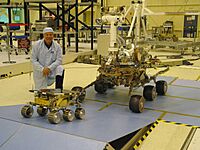
When fully lit by the sun, the rover's solar panels could generate about 140 watts of power for up to four hours each Martian day. The rover needed about 100 watts to drive. Its power system also included two rechargeable lithium ion batteries. These batteries provided energy when the sun wasn't shining, especially at night.
Scientists thought the solar panels would only make about 50 watts of power by the end of the 90-day mission, due to dust. But the rovers lasted much longer! Wind often cleaned dust off the solar panels, which helped extend the mission. During a big dust storm in 2007, both rovers had very low power. Opportunity dropped to 128 watt-hours. In November 2008, Spirit had even less, only 89 watt-hours, due to dust storms.
The rovers used a special computer system called VxWorks. It had a radiation-hardened 20 MHz RAD6000 CPU. It also had 128 MB of memory and 256 MB of flash memory. To survive, the rover's important parts had to stay between -40°C and +40°C (-40°F to 104°F). At night, eight small radioisotope heater units (RHU) kept the rovers warm. These units continuously made 1 W of heat from decaying radioactive material. Electric heaters also turned on when needed.
Communication
The rover had an X band low-gain and an X band high-gain antenna to talk to Earth. It also had an ultra high frequency (UHF) antenna to talk to spacecraft orbiting Mars. The low-gain antenna sent data slowly in all directions. The high-gain antenna was directional and could send data to Earth at a faster rate.
The rovers used their UHF antenna to communicate with the Mars Odyssey and Mars Reconnaissance Orbiter spacecraft orbiting Mars. These orbiters could receive rover signals much faster than the Deep Space Network on Earth. The orbiters then quickly sent the rover data to Earth using their large antennas.
Scientific Instruments
Each rover had nine cameras. They took 1024-pixel by 1024-pixel images. All images were compressed using a special method called ICER before being stored and sent to Earth.
Several cameras and instruments were placed on the Pancam Mast Assembly (PMA):
- Panoramic Cameras (Pancam): Two cameras with color filters. They took detailed, multi-color, 3-D panoramic pictures of the Martian landscape, sky, and Sun. They were 30 cm (11.8 inches) apart.
- Navigation Cameras (Navcam): Two cameras with a wider view but lower resolution. They were black and white and used for navigation and driving.
- Miniature Thermal Emission Spectrometer (Mini-TES): An infrared spectrometer that identified minerals in rocks and soils from a distance by sensing their heat patterns. It was specially tuned to find minerals formed in water.
These cameras were mounted 1.5 meters (4.9 feet) high on the Pancam Mast Assembly. This allowed them to rotate 360 degrees horizontally and point up or down.
Four black and white Hazard Avoidance Cameras (Hazcams) were on the rover's body, two in front and two behind. The rovers used pairs of Hazcam images to map the terrain up to 3 meters (10 feet) in front of them, helping them avoid obstacles.
The instrument deployment device (IDD), also called the rover arm, held several instruments. The arm could spin 350 degrees and rotate vertically 340 degrees. It had a maximum reach of 90 centimeters (35 inches).
- Mössbauer spectrometer (MB): Used for close-up studies of iron-containing minerals in rocks and soils. Each measurement took about 12 hours.
- Alpha particle X-ray spectrometer (APXS): Determined the chemical elements in rocks and soils using alpha particles and X-rays. Most measurements were taken at night and needed at least 10 hours.
- Magnet array: Seven magnets on each rover collected magnetic dust particles. These particles were then analyzed to find out how much magnetic material was in the dust and rocks.
- Microscopic Imager (MI): Took close-up, black-and-white, high-resolution images of rocks and soils.
- Rock Abrasion Tool (RAT): This tool, developed by Honeybee Robotics, removed dusty and weathered rock surfaces. This exposed fresh material for other instruments to examine. It could grind a hole about 45 millimeters (1.8 inches) wide and 5 millimeters (0.2 inches) deep in a rock. It could grind through hard volcanic rock in about two hours.
The robotic arm could place these instruments directly onto rocks and soil targets.
Naming Spirit and Opportunity
The Spirit and Opportunity rovers were named through a student essay contest. The winning essay was written by Sofi Collis, a nine-year-old Russian-American student from Arizona.
She wrote:
I used to live in an orphanage. It was dark and cold and lonely. At night, I looked up at the sparkly sky and felt better. I dreamed I could fly there. In America, I can make all my dreams come true. Thank you for the 'Spirit' and the 'Opportunity.'
— Sofi Collis, age 9
Before this, during their development, the rovers were known as MER-1 Rover 1 (Opportunity) and MER-2 Rover 2 (Spirit). NASA also called them MER-A (Spirit) and MER-B (Opportunity) based on which one landed first.
Test Rovers
The Jet Propulsion Laboratory (JPL) has two test rovers in Pasadena, California. They use these rovers to test things and practice situations that might happen on Mars. One test rover, SSTB1, weighs about 180 kilograms (397 pounds) and is almost exactly like Spirit and Opportunity. Another test version, SSTB-Lite, is the same size and drives the same way, but it doesn't have all the instruments. It weighs 80 kilograms (176 pounds), which is closer to what Spirit and Opportunity would weigh in Mars' lower gravity. These test rovers were used in 2009 to practice how to free Spirit when it got stuck in soft soil.
Science Discoveries
Spirit Landing Site, Gusev Crater
Plains
From orbit, Gusev crater looked like a dry lakebed. But when Spirit landed, it found that the plains inside the crater were mostly covered with rocks. These rocks were a type of basalt, which is a common volcanic rock. They looked like volcanic rocks and had small holes.
Most of the soil on the plains came from these local rocks breaking down. Scientists also found high levels of nickel in some soils, likely from meteorites.
Analysis showed that the rocks had been slightly changed by small amounts of water. Coatings on the outside and cracks inside the rocks suggested that water had deposited minerals, possibly bromine compounds. All the rocks had a thin layer of dust and one or more harder crusts. Some could be brushed off, but others needed the Rock Abrasion Tool (RAT) to grind them away.
Dust
The dust in Gusev Crater was found to be the same as dust all over Mars. All the dust was magnetic. Spirit discovered that the magnetism was caused by the mineral magnetite, especially magnetite that contained titanium. One magnet on the rover was able to collect all the dust, meaning all Martian dust is magnetic. A very thin layer of dust, less than one millimeter thick, covers everything on Mars. This dust contains a small amount of water that is chemically bound within it.
Columbia Hills
As Spirit climbed from the plains onto the Columbia Hills, the types of minerals changed. Scientists found many different rock types in the Columbia Hills. They grouped them into six categories, named after important rocks in each group. Their chemical make-up was very different from each other. Most importantly, all the rocks in Columbia Hills showed different levels of change due to water.
These rocks had more phosphorus, sulfur, chlorine, and bromine. These elements can be carried by water. The Columbia Hills rocks contained volcanic glass, along with different amounts of olivine and sulfates. The amount of olivine went down as the amount of sulfates went up. This makes sense because water destroys olivine but helps create sulfates.
The Clovis group of rocks was very interesting because the Mössbauer spectrometer (MB) found goethite in it. Goethite only forms when water is present. So, finding it was the first direct proof of past water in the Columbia Hills rocks. Also, the MB readings showed much less olivine in the rocks, even though they probably once had a lot. Olivine is a sign of no water because it breaks down easily in water. Sulfate was found, and it needs water to form.
One type of soil, called Paso Robles, from the Columbia Hills, might be a deposit left behind by evaporating water. This is because it contained large amounts of sulfur, phosphorus, calcium, and iron. Also, the MB found that much of the iron in Paso Robles soil was in an oxidized form (Fe3+), which happens with water.
Later in the mission, large amounts of pure silica were found in the soil. This silica could have come from soil reacting with acid vapors from volcanoes in the presence of water, or from a hot spring environment.
After Spirit stopped working, scientists studied old data from the Miniature Thermal Emission Spectrometer (Mini-TES). They confirmed the presence of many carbonate-rich rocks. This means that parts of Mars may have once held water. The carbonates were found in a rock outcrop called "Comanche."
Spirit found signs of slight weathering on the Gusev plains, but no clear evidence of a lake. However, in the Columbia Hills, there was clear evidence of a moderate amount of water-related weathering. This included sulfates and the minerals goethite and carbonates, which only form when water is present. Scientists now believe that Gusev crater may have held a lake long ago, but it has since been covered by volcanic materials. All the dust on Mars contains a magnetic part, identified as magnetite with some titanium. Also, the thin layer of dust covering everything on Mars is the same everywhere.
Opportunity Landing Site, Meridiani Planum
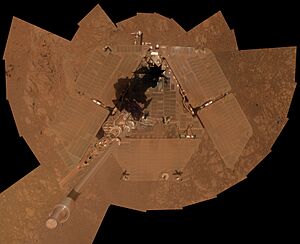
The Opportunity rover landed in a small crater called "Eagle" on the flat plains of Meridiani. The plains were covered with many small, round balls called "blueberries" by the science team. These were found loose on the surface and also stuck in the rocks. They contained a lot of the mineral hematite, and they showed signs of being formed in a watery environment. The layered bedrock in the crater walls looked like it was made of sedimentary rock. Studies showed it was mainly made of Jarosite, a mineral that forms when salty water evaporates.
The mission provided strong evidence of past water activity on Mars. Besides studying the "water hypothesis," Opportunity also made astronomical observations and gathered data about the atmosphere.
The extended mission took the rover across the plains to larger craters in the south. Eight years after landing, it reached the edge of Endeavour Crater, which is 25 kilometers (15.5 miles) wide. Orbital studies of this crater rim showed signs of phyllosilicate rocks, which are older sedimentary deposits.
Landing Locations
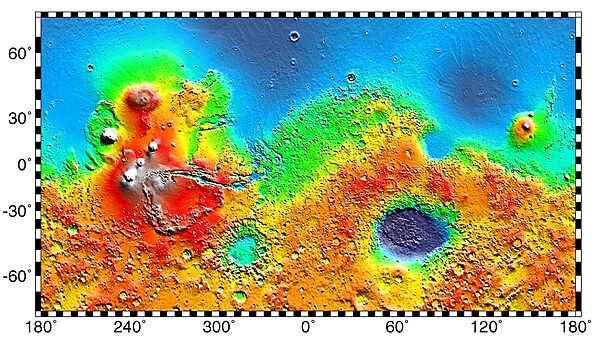
Legend: Active (white lined, ※) • Inactive • Planned (dash lined, ⁂)


